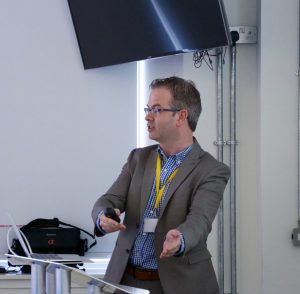Following last week’s post about #PRFest Thursday morning, this is the afternoon round-up post. Friday will follow later this week and next.
# 1 Keeping CSR simple
Nick Jones, former No.10 Digital Director and Visa Europe, now HS2, stepped up to share his experiences and best practice (and some interesting cat memes), to begin Day 1’s afternoon session on CSR. Corporate social responsibility is about doing the right thing the right way, and now is the right time to begin engaging with a new generation of communities.
 How can we keep the noise down?
How can we keep the noise down?
It’s all about listening. The more you listen, the more powerful the impact of explanations and positive responses. To achieve this, we should focus on educating and informing clients on the benefits of reaching their CSR goals. Building trust is vital, given the current climate for ‘Fake News,’ with Edelman’s Trust Barometer proving a useful measuring tool to decipher this contestable area.
It’s our job to defend our clients, whilst simultaneously aiming to persuade businesses to step up.
How does PR do the right thing?
…by encouraging CSR. There are plenty of hard and soft options available, but practitioners have the ability to cut through the noise and create thought-provoking content. Post the truth by putting an emotional response above a logical one, with the Grenfell Tower fire a clear-cut example of how critical (and potentially damaging) political responses can be. So, be aware to strike the right balance between the emotional and logical responses of CSR.
Influencing the influencers
We have to learn to flex, express things in a slightly different tone and become more circular with feedback to gain opinions and concerns. Hard CSR is what investors ask about and is one major factor that can drive shareholder activism. Always try to tie this back to the bottom line, by aligning your CSR model to meet social needs. The purpose of CSR is the why and public relations provides the means by which to bring this to life. Could you help someone find that purpose?
#2 Big Crisis Comms Questions on Cyber Security
Add a touch of humour to a thick Glaswegian accent and you have the perfect recipe for a crisis communications chat on cyber security and PR courtesy of PwC’s Craig McGill.
 Cyber is quite simply an issue everywhere. This can rank from annoying reputational issues on hacked social media accounts to a client’s worst nightmare of a corporate or financial security breach. 65% of large firms detected a cyber breach or attack in the past year, suggesting low-level security attempts are a threat to most businesses.
Cyber is quite simply an issue everywhere. This can rank from annoying reputational issues on hacked social media accounts to a client’s worst nightmare of a corporate or financial security breach. 65% of large firms detected a cyber breach or attack in the past year, suggesting low-level security attempts are a threat to most businesses.
Who is to blame?
Craig was quick to blame Chris Hemsworth for the increase, mainly due to his role as a cyber hacker in American action thriller Blackhat (2015). But, joking aside, multiple people with multiple reasons are the unfortunate reality of this paramount cyber issue.
What can we do?
The best we can do is ensure multiple systems are in place to try and deter hackers, and ultimately be ready to react when, rather than if, a breach occurs. It is better to be prepared and it never happens, than the other perilous alternative! Internal Communications is also a key issue, as cyber attacks are not just restricted to external hackers. Insiders remain the biggest security threat of all, with the top percentage of incidents found to stem from miscellaneous staff errors.
Who you gonna call?
Who do you call and who makes that call? Knowing who does what and when are important considerations. Maintaining one story and one narrative will mean people turn elsewhere for news and information, so establishing trust by informing the bigger picture proactively will be better as updates come directly from you. The best way to restore reputation is by being transparent.
How do you prioritise communication?
There is a continual need to balance who is a contact priority and how exactly they should be contacted. Multiple methods such as Facebook, official statements, email, Slack and video are options to PRs. Remember in a crisis, it’s a Comms time to shine when you can do what you need to do to keep staff happy and customers informed. The General Data Protection Regulation (GDPR) is on its way and is built around these 3 pillars: 1) transparency framework, 2) compliance journey and 3) punishment regime. So during your final checklist, make sure a fundamental basic Comms plan is in place with these areas covered.
Cyber is a key risk for business of all sizes and all industries –
Consider yourself warned!
# 3 Broadcasting and PR
 STV plc’s Paul Hughes delivered a slice of local interest as well as providing insight into the future of media PR during his television chat.
STV plc’s Paul Hughes delivered a slice of local interest as well as providing insight into the future of media PR during his television chat.
Reinventing the wheel
He recounted the story of STV 2 beginning with the arrival of STV Glasgow and STV Edinburgh. Then the addition of licences for Aberdeen, Dundee and Ayr to make up a 5 licence channel across Scotland. It’s Scotland’s newest TV channel that primarily focuses on local stories that viewers can’t get anywhere else on television.
Great local appetite
After a predictable teething period the channel became known for developing people and ideas as well as experimenting and taking risks that aren’t possible on the main networks. The result is a channel that has core local programming at its heart based around STV New Tonight, Live at Five, Peter and Roughie and the Late Show as well as a host of popular dramas. The channel also covers a number of Scottish events including a month of daily programmes around the Edinburgh Festival and the U17s Glasgow Cup final that drew an audience of over 200k viewers.
Myth busting
Television is often regarded as difficult to access by PRs in the UK because traditionally there has been little in the way of local broadcasting while the opposite is true in the US where local TV is often the primary goal. In the UK there is also a PR focus on news. Now Scotland has a channel that not only has more news but also significant non-news, feature programmes as an alternative platform the PR industry is increasingly engaging with.
STV predictions
Hughes said there is already some evidence that the marketing and PR industry are re-assessing the balance between digital and broadcast in terms of credibility, engagement and effectiveness. Three quarters of Scots said television influenced their decision making in the recent elections. He predicted a noticeable global sway back towards curated, reliable media. Also, that linear TV viewing remains strong. This, he argued, presents an opportunity to forward-thinking PRs.
#4 PR Management Today
Through the fiercely fabulous delivery of Sarah Hall, MD of Sarah Hall Consulting, #FuturePRoof founder and CIPR President-Elect, we once again looked at PR as a management discipline and how this is a real industry opportunity.
 During her presentation, Hall built on last year’s deck and referred to the Global Alliance Competency Framework, which she urged practitioners to benchmark themselves against. It is a key mission of the Global Alliance to find the standards that unite us while identifying the diversity among the many ways in which public relations and communication management are practised. Through this mission, the members of the Global Alliance hope to jointly raise the standards and to globalize our profession.
During her presentation, Hall built on last year’s deck and referred to the Global Alliance Competency Framework, which she urged practitioners to benchmark themselves against. It is a key mission of the Global Alliance to find the standards that unite us while identifying the diversity among the many ways in which public relations and communication management are practised. Through this mission, the members of the Global Alliance hope to jointly raise the standards and to globalize our profession.
Blurred Lines
Hall suggests the blurring of marketing disciplines is positive for the public relations industry as it creates new opportunities. However to unlock these opportunities, we have to be able to operate strategically and command the attention of the Board. By approaching PR as a management discipline, this changes our approach to CPD, and in turn how we approach the C-Suite.
PRs have to educate employers that we are not just a delivery function but the eyes, ears and conscience of an organisation with the insight to help plan for the future and ability to instigate positive change. PR delivers incredible value against organisational objectives when deployed effectively. For that reason, we deserve more respect and increased investment into our services.
Essential function
With many changes in politics, society, media and tech today, this all has a knock-on effect on how businesses and industries operate. Management teams are looking to PR practitioners to help them navigate through this uncertainty and period of upheaval. Practitioners with business management and financial skills as well as tactical proficiency are well placed to capitalise – indeed many are already.
People also expect more for their brand loyalty during times of upheaval and austerity. PR is the discipline that manages reputation and builds longterm relationships so is the obvious choice to turn to. Consider the lifetime value of a customer, which is what PR offers, versus a one off sales hit. If you were a brand, which would you choose? We have got to speak up in order to be heard.
What is your Legacy?
Reputation is a fragile thing, taking years to grow and a matter of minutes to destroy. Organisations MUST be able to respond in an agile and responsive manner to issues and truly live their values. Company with a gap between what they say and do will be called out and judged against it. PR advisers should make it part of their role to ensure their management teams do the right thing. History is watching, so what will you make your legacy?
Call to Action
The role of any organisation shouldn’t just revolve around money making and profits – brands should also add organisational and societal value, especially when times are hard.
PR professionals can and do set the strategic direction where deployed properly by those at the top of their game. The management demand is there; forward-thinking and engaged organisations already look to their comms people to help them maintain their legitimacy within society. Many also ensure all the other marketing functions answer to the public relations department.
So be honest, benchmarking yourself against the Global Alliance framework, can you really call yourself a strategic advisor? If not, what are you waiting for – go upskill!
#5 PR Stunts or Stunted?
We rounded up Day 1 of #PRFest reminiscing over a flurry of highly successful, if somewhat controversial, PR campaigns, with Rich Leigh out to prove stunts are definitely not a thing of the past.
A True PR Stuntman
Leigh made it clear that stunts are just part of the enjoyment of PR and sometimes we forget how fun it really is because they “get a really, really bad rep.” The term PR stunt, according to Leigh, as been coopted, stripped apart from his interpretation of the term.
Reasons for past failures
Lack of measurability; of course we can measure our successes via Google goals and other methods. We also can’t dispute the figures when a sharp increase in donations occurs directly following a campaign.
Not being serious: videos on serious topics can still have the desired impact, it’s just a matter of developing a creative idea that can be validated to make a difference.
Not good value for money: direct sales can be measured from well-aimed or controversial campaigns. Never underestimate their perfect headline grabbing potential.
Good Stunts & Common Themes
All good PR stunts have a few things in common. Usually they are explainable in a sentence, clearly relate to the product or service, offer visual content and address clear and measurable objectives. By reaching your intended audience and provoking a reaction, this simultaneously answers the client brief whilst inspiring thought, shock, debate or entertainment value.
Dos and Don’ts of Stunt Ideas
Do think creatively. This applies to be both reactive and seasonal stunts, as well as longer campaigns (perhaps seeking to engage then re-engage an audience). Do not shoehorn a good idea and/or make the mistake of rushing to use a new medium or technology. Neither should you mistake headlines and re-tweets for success, because outside of PR, who really knows or cares? The final ‘don’t’ of the day is awards do not a happy client make, for they don’t always guarantee returns.
Blog post drafted by Hannah Smithdale (@PRBee_16), edited by Laura Sutherland and approved by speakers.
